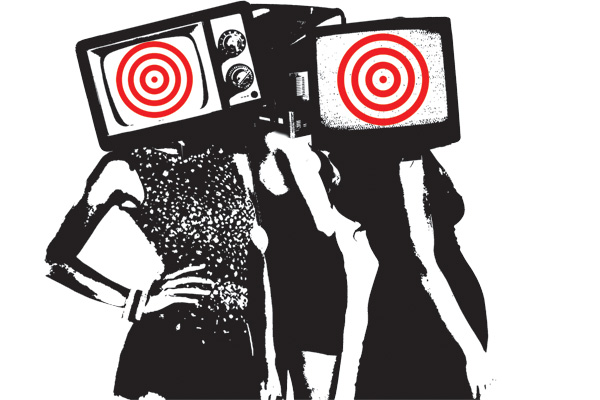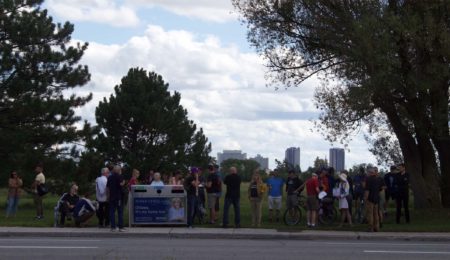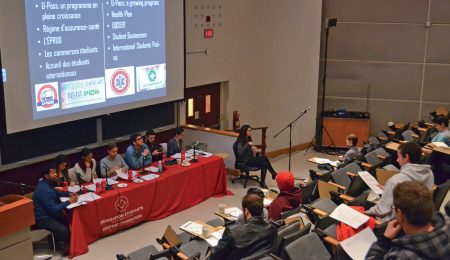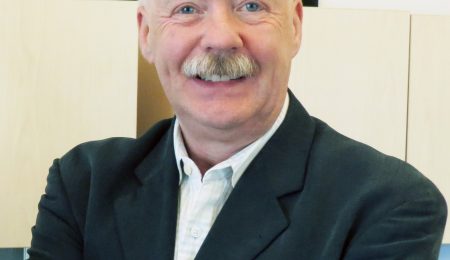Are we seeing a rise in sexual assaults in Ottawa? The news might make it seem that way, but Kiera Obbard looks at what it really means when the media reports on these types of incidents — and when they don’t.
Photo illustration by Tina Wallace
Ottawa has seen a notable rise in reported assaults on women in the media over the last couple months. Incidents such as the hair cutting on Preston street, the break-ins and attempted sexual assaults in Sandy Hill, and reports of sexual assaults in taxi cabs have had prominent media coverage since September, and have left many women feeling frightened while walking the streets, taking public transit, or even hailing a cab. Earlier this month, the Ottawa Police Service (OPS) even announced that a serial rapist is at large in the city.
Reports like these pose an uncomfortable but unavoidable question: Are we seeing a rise in sexual assaults in Ottawa?
According to Staff Sergeant Angela McDade of the Sexual Assault and Child Abuse Unit of the OPS, that’s hard to say.
Over the past few months, the city has been bombarded by media coverage informing the public of sexual assaults across the city. However, determining whether there is a statistical increase in sexual assaults is much more complicated than simply relying on what’s shown by the media.
There are a variety of categories listed by Statistics Canada that haven’t necessarily seen a rise in number, such as voyeurism, sexual assault, and sexual interference. But one in particular has risen.
“The category of sexual assault includes inappropriate touching, and these statistics have increased,” said McDade.
Police statistics can see an increase based on a number of factors that don’t necessarily indicate an increase in sexual assault cases. For example, more women may report cases to the police or one perpetrator may commit a number of offences.
According to McDade, mainstream and social media coverage may have an impact on public awareness of the attacks and, subsequently, the number of attacks reported. However, she said determining the cause for the spike of reported sexual assaults is a complicated process.
“Whether media attention and social media played a role in the increase in reporting or whether one individual was responsible for more than one offence is hard to determine without going through each report and reading the details,” she said.
What’s in the news?
Holly Johnson, a criminology professor at the University of Ottawa, said seeing more media coverage of sexual assaults doesn’t mean they’re on the rise. Likewise, a lack of media coverage doesn’t indicate a decrease in sexual assaults.
“These things get attention in the media every now and again, and then they’ll die down,” she said. “Does that mean there are fewer? No. It just means that the media is not picking them up, or women aren’t coming forward, or that for whatever reason, the media is on to something else.”
Although the media will make people aware of these attacks, Johnson said it may not be the most reliable indicator of what’s actually going on in the city.
“The media is a very poor representation of what goes on in any aspect of crime,” she said. “It doesn’t sell unless it’s unusual or horrific or scary or there seems to be some sort of a pattern. The media doesn’t pick up the routine kind of sexual assaults, in clubs, for example.”
Statistics Canada reports that less than 10 per cent of sexual assaults are reported to police, meaning that the media publishes a small fraction of the sexual assaults that actually occur in the city. Additionally, the stories in the media are typically ones that fit into a traditional narrative and are often committed by a perpetrator who’s a stranger to the survivor — even though statistics tell us the vast majority of sexual assaults are committed by someone the survivor knows.
Whose stories get told?
According to Yamikani Msosa, a public education coordinator and support worker at Ottawa’s Sexual Assault Support Centre (SASC), the first step toward media coverage is being able to report the assault.
“More often than not, it’s the police who send out a press release, and then the media picks up on it based on something that was reported,” she said. “I think the discrepancy lies in the ones that were able to go to the police and be believed and not discredited, because we can’t take out the factor that issues of marginalization do play a role in a survivor’s credibility.”
If a woman reports her attack to the police and if her case isn’t classified as unfounded, the police may issue a news release informing the media and the public about the incident. Alternatively, an agency such as the Ottawa Rape Crisis Centre (ORCC) or Hollaback! Ottawa — a movement dedicated to ending street harassment using mobile technology — can report on a woman’s behalf.
Msosa said the representation of sexual assault in the media doesn’t depict the reality of sexual assault in Canada, but instead uses a stereotypical “rape narrative” that can be harmful to the public’s understanding of what sexual assault actually is.
“Within the media, there’s a narrative of ‘stranger danger,’” she said. “The problem with that, of course, is that it happens everywhere, anywhere, and at any time. That’s not to say that no one is safe, but it is to say that the prevalence of sexual assault in Ottawa, and in society, is not just a couple of incidents. If we start to picture it as 100 incidents of sexual assault in a day, then that would change the way that we think when we do see the media coverage around these experiences.”
The term “stranger danger” refers to the potential risk posed by unknown persons and, in the context of sexual assault, often focuses on the danger that these persons pose to women when out alone late at night or in isolated places. Julie Lalonde, director of Hollaback! Ottawa, said the problem with this narrative is that it glosses over the majority of sexual assault experiences.
“In Canada, 80 to 95 per cent of people are assaulted by someone they know, in their own home, or on a campus,” she said. “Playing up stranger danger is actually re-victimizing and putting women in harm’s way, because they’re telling themselves, ‘What my partner just did to me was not rape because rape is when I’m attacked in the park walking home from work.’”
Misrepresentation
The problem with this representation of sexual assault is that it creates a specific idea of what counts as sexual assault, an idea that is perpetuated in media reports that focus on sexual assaults by strangers. This narrative is further reinforced through prevention tips given to women, by the media and the police, in order to encourage them to protect themselves from stranger attacks, like using the buddy system at night or abstaining from alcohol.
In late October, a collective member of SASC wrote a letter published in the Ottawa Citizen calling on the media to stop sensationalizing sexual assault. The letter urged community and media members to stop telling women how to protect themselves against stranger assaults.
“The media needs to stop telling us to not wear headphones or walk in buddies because the reality is sexual violence doesn’t (only) happen on the streets,” said Msosa. “You’re putting more blame on the woman if she doesn’t adhere to all the requirements of keeping safe.”
Ottawa police have an obligation to inform the public of sexual assaults and to provide women with prevention tips to help keep them safe, but the framing of these messages is particularly important because prevention tips shift the responsibility of being assaulted onto the survivor rather than emphasizing that sexual assault is a crime.
According to Johnson, giving women tips on how to protect themselves from potential attacks isn’t an effective form of prevention because it fails to focus on the perpetrator’s actions and also because it’s something that women grow up learning how to do regardless. Instead of telling women how to keep safe, the media and police should be telling men, not to rape, she said.
The pornographic spectacle
In November, the Ottawa Sun reported on an incident on Preston Street during which a man had cut off a woman’s hair. In the article, the reporter wrote that this type of assault can be linked to sexual sadism. According to McDade, the incident in question was not classified by police as a sexual assault. With no evidence linking the incident to a sexual assault, why would a reporter make the connection?
Ultimately, mainstream media outlets are designed to make a profit. Certain cases, like a serial rapist on the loose, generate significant public interest, which can lead to an increase in readership. For Msosa, media representation of sexual assault becomes a problem when it sensationalizes a sexual assault story in order to, presumably, make money.
“I think with media coverage comes sensationalism,” she said. “From our perspective at SASC, we would ask the woman how she felt about the incident instead of jumping to conclusions for women.”
Lalonde said what was really missing from the story was the level of violation the woman experienced, a perspective only accounted for when the woman actually came forward and spoke for herself.
“That’s the piece I find often missing in all of these stories, whether it’s this kind of bizarre physical attack, a sexual assault in the traditional sense of the word, street harassment—it’s a violation of another person’s personal space, their bodily autonomy, their integrity,” said Lalonde.
Erin Crickett, a public educator at the Sexual Assault Centre Hamilton and Area, said this type of speculation doesn’t have survivors’ best interests in mind.
“There are so many other details that even the Sun doesn’t know,” she said. “We don’t know why that person is cutting women’s ponytails off. For me, it’s violence, and the fact that the Sun is focusing on whether or not it’s sexual violence, I don’t think they have survivors’ best interests, healing, and recovery, and survivors seeking justice in mind.”
Media sensationalism may also force the survivor to relive her attack, to see it played out in the media on public display in a way that’s beyond what’s necessary to serve the public good.
British feminist sociologist Carol Smart refers to the media representation of rape and rape trials as a pornographic spectacle, where the well-being of the survivor falls behind the importance of using sensationalized narratives to gain readers or popularize a case.
In early October, the CBC reported an assault near the Heron bus station. In an article and video, two men who helped the survivor immediately after the assault were interviewed. They discussed specific details about the survivor’s clothes and appearance after her assault.
“Referring to the assault at Heron, why did the media have a lengthy interview with two men who found the woman half-dressed running through the street?” said Lalonde. “Why did you have to have an interview with those two men going into graphic detail about what this woman looked like when they found her?”
Although she acknowledged the good relationships she has with individuals in major media outlets in Ottawa, Lalonde urges readers to be critical when reading and viewing media coverage of sexual assault. She said media consumers should also consider the editorial practices that aren’t always evident to the public, like which voices were chosen to be included in an article.
“Those are the things that I’m concerned about — whose voices are being heard, and what are the critical voices,” she said.
Progress with Ottawa police
Since the spike in reported sexual assaults in Ottawa began in September, police have made multiple efforts to catch the perpetrators and to prevent more assaults from happening. On Oct. 11, the OPS issued a media release advising the community that additional resources had been added to investigate the sexual assaults.
According to McDade, the OPS also works closely with organizations that offer different resources for survivors of assaults, like the Ottawa Coalition to End Violence Against Women, the Sexual Assault Network, the Ottawa Hospital, and the ORCC.
Also in October, Hollaback! Ottawa published an open letter that criticized how the police, the media, and City Hall were framing the discussion of sexual violence. The letter pointed to the problems with telling women they must protect themselves from sexual assault instead of focusing on the perpetrators.
The OPS press conference on Jan. 10, in which Police Chief Charles Bordeleau announced the force’s plans to come down hard on perpetrators of sexual assaults, is a big step toward more and more survivors reporting their assaults, said Lalonde.
“Ottawa has one of the highest unfounded rates in the country, which means you are more likely to be told in Ottawa that there’s not enough evidence to go forward with your rape than any other city in the country. We have that, on top of the fact that we have the police saying you can’t go outside at night, you have most people assaulted by someone they know, you have the media only reporting on stranger assaults,” she said.
“All of these pieces need to be seen as a bigger picture. For the chief to come out very strongly saying this is crime, this is violence against women, this is not to be tolerated, we are going to find you, someone in Ottawa knows who you are, please come forward, we want to prevent this from happening to other women — that’s strong messaging that I hope we hear more of.”
Johnson said the problem in framing sexual assault is not necessarily just with the police, but is indicative of a larger societal problem.
“We all walk around with these very damaging rape myths, so why wouldn’t the police too?” she said.
Media changes
According to Crickett, the first step in building more ethical media practices begins with having every member of the media read the Femifesto toolkit on reporting sexual assault, which outlines the proper language to use when writing about rape.
“We need more survivors telling their stories and there are really good reasons why survivors are not able to,” she said. “That’s why the media gravitates towards more of those stranger rape stories. I would just like to see a more wholesome and inclusive space that takes in survivors’ needs and wants, and treats the survivor like a person instead of treating them like a story or a thing that happened to them.”
In addition to creating more inclusive spaces, Msosa would like to see a focus on community accountability and ways that people can help stop sexual assault, including practical strategies for intervening.
“In an ideal world, I want the community accountability to be there for survivors,” she said. “I would love to see the conversation shift from being, ‘This incident happened, women beware,’ to, ‘This incident happened, let’s all come together to figure out how we can keep our community safe.’”





